标签:des style blog http color os io ar strong
A system and method for?address?space?layout?randomization?("ASLR") for a Windows operating system is disclosed. The?address?space?layout?includes one or more memory regions that are identified and then a particular implementation of the system randomizes the identified memory region in order to prevent any software vulnerabilities.
The present document relates to a method of protecting an operating system from software vulnerabilities, and more particularly to a method of?address space?layout?randomization?for a Windows operating system.
There are a number of ways by which an attacker can execute arbitrary code on a target machine, such as a personal computer, in order to gain control of that target machine. However, a given attack vector must provide an attacker with the ability to either directly or indirectly alter the execution path of a software program or a process in a controllable and desired fashion such that the process can be altered to run software code supplied by the attacker in order to gain control of the target machine.
As such, the attacker must have some sort of knowledge about the?address space?layout?of the process being attacked. Knowledge of the?address?space layout?for a particular process allows an attacker to redirect execution to the attacker‘s controllable location in memory, thereby allowing an attacker to execute arbitrary code in a Windows operating system and gain control of the target machine.
An?address?space?layout?may include multiple segments such as stacks, heaps, memory mapped files, arbitrary memory allocations, executable image mapping, DLL image mappings, TEB(s) and a PEB. Stacks, heaps, memory mapped files, arbitrary memory allocations and executable image mappings are found in most common operating systems, while the PEB ("Process Environment Block") and the TEB ("Thread Environment Block") are memory region types unique to the Windows operating system.
To date, there have been a number of implementations that have tried to either partially or universally stop exploitation of software vulnerabilities, such as Address?Space?Layout?Randomization?("ASLR"). ASLR is a term that is used to describe the action of making the?address?space?layout?for a particular process‘ virtual?address?space?unpredictable, either wholly or in part. Although the means of implementing ASLR varies greatly depending on the particular platform, it usually involves randomizing certain types of memory allocations across the span of a process‘ execution.
The major benefit of ASLR over other approaches is that the impact on performance of the process incurred by?randomization?of the?address?space?is negligible. ASLR also has the benefit of not breaking legacy applications that rely on writable memory regions remaining executable. In addition, ASLR is the only method that, when done in whole, can prevent every known method of exploitation that relies on knowing something about the?address?space?of a target process.
However, there is a need in the art for an ASLR system for a Windows operating system in order to protect such an operating system from attack as well as mitigate a large class of vulnerabilities inherent in the Windows operating system. In addition, there is a need for an SEH overwrite protection for a Window operating system.
In one embodiment a system for?address?space?layout?randomization?may include an?address?space?having one or more different types of memory regions, the ASLR system further including a means for identifying the type of memory region in the?address?space, and randomizing each type of memory region in the?address?space?once said one more different types of memory regions are identified.
In another embodiment a method for randomizing one or more memory regions includes identifying whether the memory region is a file mapping and then determining whether the memory region is an image file if the memory region is a file mapping.
Implementation of the above embodiments may include one or more of the following features:
Additional objectives, advantages and novel features will be set forth in the description which follows or will become apparent to those skilled in the art upon examination of the drawings and detailed description which follows.
FIG. 1?is a simplified block diagram illustrating the basic concept of an ASLR system;
FIG. 2?is a simplified block diagram of an?address?space?for a Windows operating system illustrating the various memory regions of the?address?space;
FIG. 3?is a flow chart illustrating a general overview of ASLR implementation for a Windows operating system;
FIG. 4?is a flow chart illustrating an overview of one implementation of the ASLR system related to memory allocation memory region;
FIG. 5?is a flow chart illustrating another implementation of the ASLR system related to a PEB or TEB memory region;
FIG. 6?is a flow chart illustrating an overview of another implementation of the ASLR system related to file mapping memory region;
FIG. 7?is a flow chart illustrating an overview of the ASLR system of?FIG. 4related to the image file mapping memory region;
FIG. 8?is a flow chart illustrating another implementation of the ASLR system related to the memory allocation memory region;
FIG. 9?is a flow chart illustrating another implementation of the ASLR system related to the file mapping and image file mapping memory regions of?FIGS. 6 and 7, respectively;
FIG. 10?is a flow chart illustrating a subroutine for the ASLR system of?FIG. 9;
FIG. 11?is a flow chart illustrating a subroutine of the ASLR system of?FIG. 10;
FIG. 12?is a flow chart illustrating a subroutine of the ASLR system of?FIG. 11;
FIG. 13?is a flow chart illustrating a subroutine of the ASLR system of?FIG. 12; and
FIG. 14?is a flow chart illustrating a method of an SEH overwrite protection.
Corresponding reference characters indicate corresponding elements among the several views. The headings used in the figures should not be interpreted to limit the scope of the figures.
Referring to the drawings a system and method for implementing an?address space?layout?randomization?("ASLR") is illustrated and generally indicated as?10in?FIG. 1. Referring to?FIG. 1, the ASLR system?10?provides a means of protecting a target machine(s)?4?being run on a Windows operating system?8("Windows platform") from an attacker?6?seeking to execute arbitrary code on a process?9?being run on target machine?4. As discussed earlier, an attacker?6may execute such arbitrary code on process?9?by exploiting software vulnerabilities inherent in an?address?space?16?found in memory?7?of a particular target machine?4.
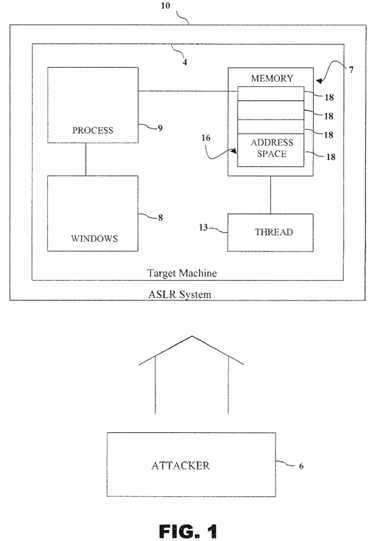
Exploiting such software vulnerabilities requires that the attacker?6?have some knowledge about the?layout?of the?address?space?16?of the process?9?being attacked. In one implementation, a system and method for preventing execution of such arbitrary code by an attacker?6?includes randomizing different portions of the?address?space?16?in such a manner that an attacker?6?is prevented from running arbitrary code in order to directly or indirectly alter the execution path of process?9?in a controllable and desirable fashion.
As shown in?FIG. 2, the?address?space?16?may include various memory regions18?for a particular process?9. These memory regions?18?may include stack(s)20, heap(s)?22, memory mapped files?24, arbitrary memory allocations?26, executable image mapping?28, DLL image mappings?30, TEB(s)?32?and a PEB34. In particular, one or more implementations of ASLR system?10?will be used to randomize one or more memory regions?18?of the?address?space?16?in order to prevent a software vulnerability that could be exploited by the attacker?6.
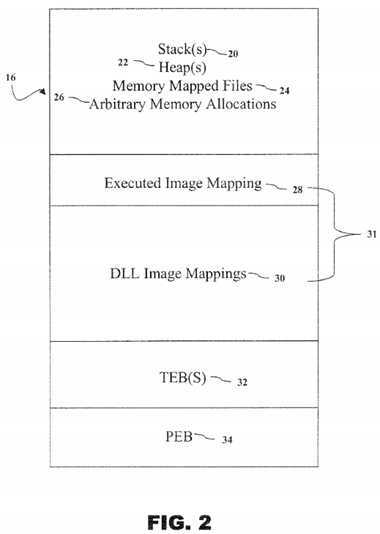
As used herein, a stack?20?is used to store data and control information for one or more frames of execution associated with a given thread?13, while a heap?22 is used to store globally scoped data. Memory mapped files?24?are regions of memory?7?that are backed against a non-image file on disk (not shown) instead of Random Access Memory ("RAM"). Further, an arbitrary memory allocation?26of the?address?space?16?is an allocation of a memory region?18?with RAM that the Windows platform?8?provides such as a heap?22, rather than as a file on a disk. The executable image mapping?28?is fundamentally the same as a DLL image mapping?30?and are collectively referred to as an image file mapping?31. Finally, a PEB?34?is used to store globally accessible control structures and variables that are used internally by Microsoft? during the course of a process‘9?execution, while the TEB?32?is used to store information about and for a given thread?13, such as error codes, thread?13?local storage, and other attributes unique to a single thread?13. As used herein, thread?13?may be defined as a sequence of instructions which may execute in parallel with other threads.
As shall be discussed in greater detail below, various implementations of the ASLR system?10?are adapted to randomize a respective memory region?18?of?address?space?16?in a manner that prevents exploitation of software vulnerability. A general overview of the ASLR system?10?is discussed below followed by specific discussions related to various implementations of ASLR system?10?for randomizing each type of memory region?18.
Referring to?FIG. 3, an overview of the steps taken by ASLR system?10?to randomize each respective memory region?18?of address?space?16?is illustrated. At step?100, memory may be allocated by ASLR System?10?for a user mode process?9through calls to ntdll!NtAllocateVirtualMemory and ndtll!NtmapViewOfSection. Once completed, the ASLR system?10?at decision point?102?must determine whether a particular memory region?18?is a file mapping?14?or not. If a particular memory region?18?is a file mapping?14, then the ASLR system?10?proceeds to decision point?104. If not, then ASLR system?10?proceeds to decision point?112.
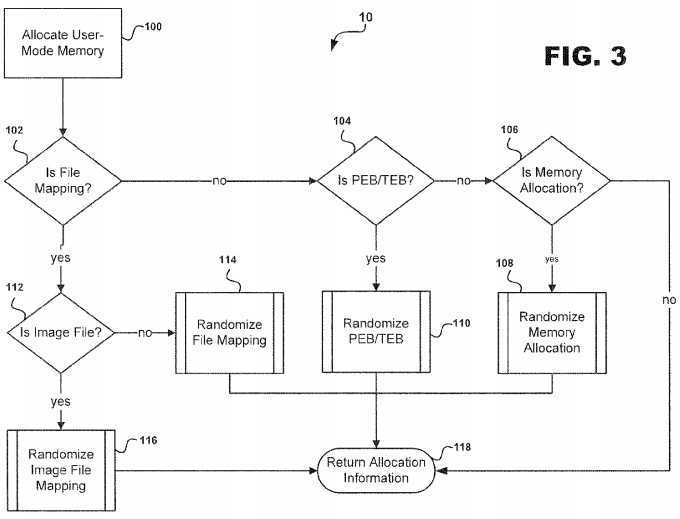
At decision point?104?ASLR system?10?determines whether memory region?18?is a TEB?32?or PEB?34. If the memory region?18?is identified as either a TEB?32?or a PEB?34, then ASLR system?10?proceeds to execute subroutine?110?which randomizes the TEB?32?or PEB?34. If not, ASLR system?10?proceeds to decision point?106?which determines that the memory region?18?is an arbitrary memory allocation?28?and then executes a subroutine?108?which randomizes the arbitrary memory allocations?26. If the ASLR system?10?determines that the memory region is not an arbitrary memory allocation?26, then the system?10?proceeds to step?118?for return allocation information.
At decision point?112, the ASLR system?10?determines whether the memory region?18?is an image file mapping?31?or not. If the memory region?18?is not an image file mapping?31, then system?10?proceeds to execute subroutine?114?which randomizes the memory region?18?as a file mapping?14. If the memory region?18?is an image file mapping?31, then ASLR system?10?proceeds to execute subroutine?116?which randomizes the memory region?18?as an image file mapping?31. Once either subroutines?108,?110,?114?or?116?are executed and completed in such a manner that prevents exploitation of any software vulnerability, the ASLR system?10?proceeds to step?118?for return of allocation information.
The term memory allocation, as used herein, means a generic grouping of arbitrary purposed memory segments in a process?9, such as thread stacks?20?and heaps?22. The majority of memory allocations that are mapped into the?addressspace?16?of process?9?over time are executed at the request of process?9, rather than being executed for the thread?9?by the kernel.
Referring to?FIG. 4, the subroutine?108?for randomizing the arbitrary memory allocation memory region is illustrated. At step?200, memory may be allocated for a user mode. The ASLR System?10?proceeds to step?202?wherein an ntdll!NtAllocateVirtualMemory calls into the kernel (not shown) which is handled at nt!NtAllocateVirtualMemory that permits allocation of an arbitrarily sized memory region?18?at an arbitrary?address?(either fixed or dynamically chosen). Callers of NtAllocateVirtualMemory also have the ability to control the page protection and are able to specify the type of allocation to be performed, whether it be to commit pages to memory or to reserve such pages for future use.
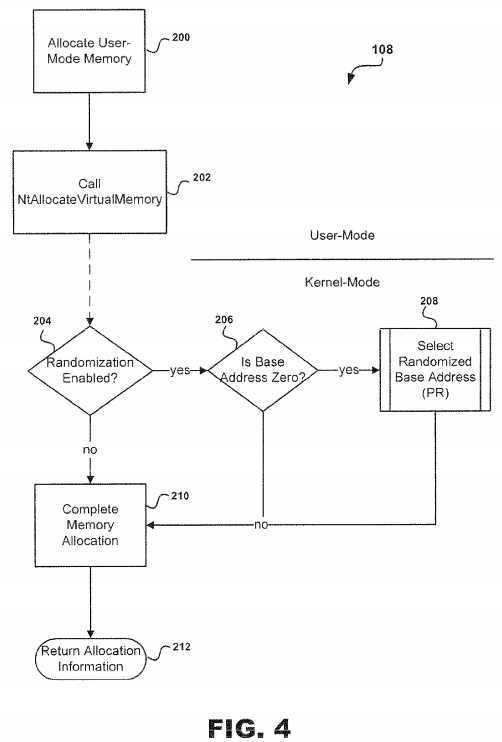
At decision point?204, ASLR System?10?determines whether?randomization?is enabled or not. If the?randomization?is enabled, then at decision point?206?ASLR System?10?determines whether the base?address?of?address?space?16?is zero. If the?randomization?is not enabled, then at step?210?memory allocation is completed and ASLR System?10?proceeds to step212?for return of allocation information.
However, if it is determined that the requested base?address?is zero, then the ASLR system?10?implements a subroutine208?that selects a randomized base?address?using an algorithm. Once completed, the ASLR System?10?proceeds to steps210?and?212?as described above. However, if the ASLR System?10?determines that the base?address?is not zero, then the System?10?proceeds directly to steps?210?and?212?and the allocation is completed.
In order to robustly implement?randomization?of memory allocations that are performed by way of nt!NtAllocateVirtualMemory, a kernel-mode driver must be implemented that layers between callers of nt!NtAllocateVirtualMemory and its implementation. This allows for catching allocations that are originally both in user-mode and kernel-mode.
Referring to?FIG. 8, a more detailed description of steps?204-210?of?FIG. 4?will be discussed. The NtAllocateVirtualMemory hook is used to provide support for randomizing arbitrary memory allocations?26, such as a stack?20, heap?22, and other allocations achieved through the use of VirtualAlloc and NtAllocateVirtualMemory directly. At decision point?600, ASLR system?10?determines whether the PreviousMode is in UserMode? If so, then at step?602?ProbeforWrite BaseAddress and RegionSize. Steps?600?and?602?are required in order to ensure that the output parameters are valid such that an attacker6?cannot lead to a Windows operating system?10?crash by specifying invalid parameters. Once completed, then at decision point?604?the ASLR system?10?determines whether the BaseAddress is zero. If the PreviousMode is not in UserMode, then the system?10?proceeds to decision point?604?in order to determine whether the base?address?is zero.
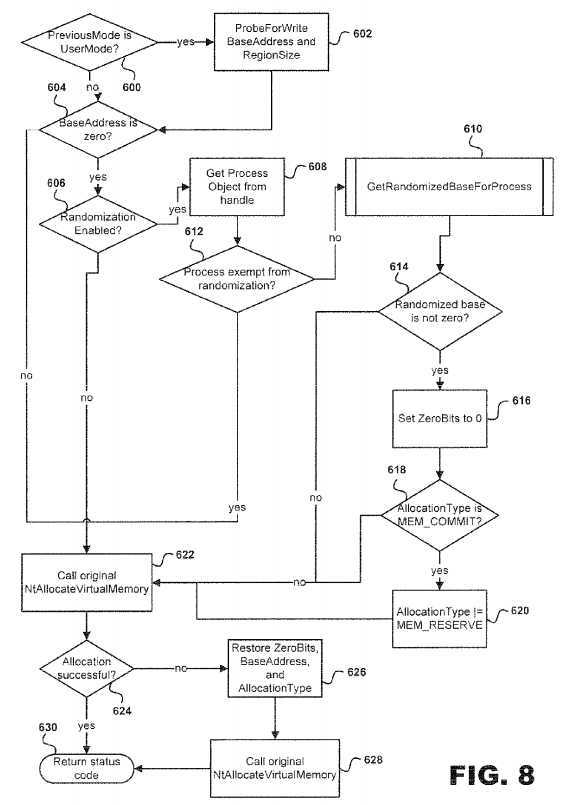
If the BaseAddress is zero, then the ASLR system?10?proceeds to decision point?606?in order to determine whetherrandomization?has been completed. However, if the BaseAddress is not zero then the system?10?proceeds to step?622?for calling an original NtAllocateVirtualMemory.
At decision point?606, if?randomization?has been enabled, then the ASLR system?10?proceeds to step?608?in order to get a process object?9?from the handle that was passed to NtAllocateVirtualMemory before reaching decision point?612?in order to determine whether the process?9?is exempt from?randomization. However, if?randomization?has not been enabled, then the ASLR system?10?proceeds to step?622?as described above.
At decision point?612, if the thread?13?has not been exempt from?randomization, then a subroutine?610?is executed for a GetRandomizedBaseforProcess application before proceeding to decision point?614?in order to determine whether the randomized base is zero. However, if the thread?9?is exempt from?randomization, then the ASLR system?10?proceeds to step?622?as described above.
At decision point?614, if the randomized base is zero, then at step?616?the ASLR system?10?sets ZeroBits to 0 before proceeding to decision point?618?in order to determine whether the AllocationType I=MEM_COMMIT. If the AllocationType I=MEM_COMMIT, then the AllocationType is set at I=MEM_RESERVE at step?620?before proceeding to step?622?as described above. However, if the AllocationType is not set at MEM_COMMIT then the ASLR system?10?proceeds directly to step?622.
After step?622?is executed, then the ASLR system?10?proceeds to decision point?624?in order to determine whether the Allocation was successful. If the Allocation was successful, then the Return status code is executed at step?630. However, if the Allocation failed, then the ASLR system?10?proceeds to step?626?in order to Restore ZeroBits, BaseAddress, and AllocationType. This is done in order to allow the allocation to succeed even if the ASLR system?10?was unable to allocate memory?7?at the randomized base?address. After the parameter values are restored the operation completes by calling the original NtAllocateVirtualMemory at step?628. Once completed, the ASLR system?10?proceeds to step?630?as described above. In one implementation, if the allocation failed after?randomization, the ALRS system?10?may try the allocation again without any randomized base?address?this time.
A more detailed discussion of this particular implementation of ASLR System?10?may be found in the related provisional patent application previously incorporated by reference.
The TEB?32?and PEB?34?are both internal data structures that are used by both the process?9?and the Windows platform?8to track the state of execution of process?9?in a globally accessible location. Since the TEB?32?and PEB?34?are internal data structures, the procedure involved in mapping the TEB?32?and PEB?34?into the?address?space?16?of thread?9?is handled by the kernel, for example by ntosknrl.exe.
In addition, the implementation of ASLR system?10?used to randomize the TEB?32?and PEB?34?takes advantage of the fact that both memory regions?18?rely on the field nt!MmHighestUserAddress when these types of memory regions?18?are being mapped into memory?7. As such, adjusting nt!MmHighestUserAddress by a random number of pages makes it possible to make the?address?at which the TEB?32?and PEB?34?will be mapped to be random. The adjustment cannot exceed a value that causes nt!MmHighestUserAddress to fall below 0x7ffefff, however, due to the fact that this would make required portions of the user-mode?address?space?unavailable to the process.
Referring to?FIG. 5, the subroutine?120?for randomizing either the TEB?32?or PEB?34?is illustrated. At step?300, ASLR system?10?is booted followed by step?302?wherein the ASLR Driver (not shown) is initialized. After the ASLR Driver is initialized, ASLR system?10?proceeds to decision point?304?to determine whether the PEB?34?and TEB?32?is enabled. If the PEB?34?and TEB?32?is enabled, then at step?306?the value of nt!MmHighestUserAddress is adjusted in order to modify the locations of the PEB?34?and TEB?32?of memory region?18. This field is randomized by a small degree such that allocations will occur at different offsets relative to the top of the user-mode?address?space?16. After step?306, the ASLR system?10proceeds to step?308?and ASLR Driver initialization is completed.
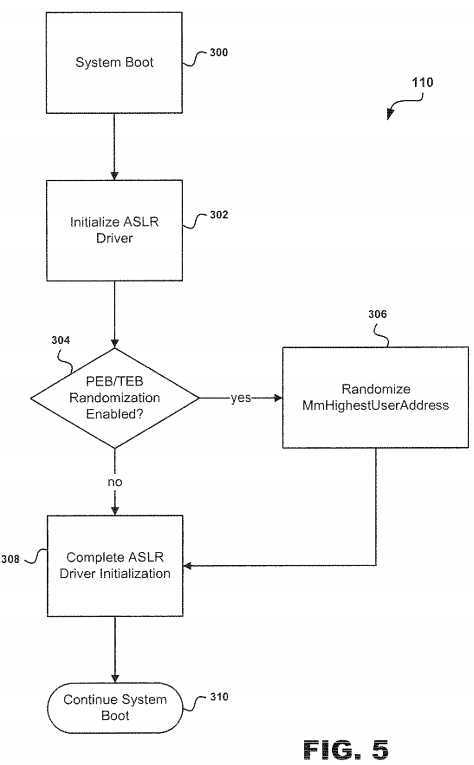
However, if the PEB?34?and TEB?32?are not enabled at decision point?304, then the ASLR system?10?proceeds directly to step?308?for completing the ASLR Driver initialization. After step?308?is completed, the ASLR system?10?proceeds to step310?in order to continue the system boot.
A more detailed discussion of this particular implementation of ASLR System?10?may be found in the related provisional patent application previously incorporated by reference.
File mappings?14?can be typically loaded at the same base?address?of the?address?space?16?from one execution of process?9?to another execution, thereby allowing an attacker?6?to assume that a given instruction, such as a jmp esp instruction, will exist at the same base?address?between multiple target machines?4. A base?address?as used herein is defined as a memory?address?serving as a reference point ("base") for other memory addresses.
In one implementation, ASLR system?10?provides a means for randomizing a file mapping?14?such that the file mapping?14is not loaded at the same base?address?of?space?address?16?that prevents exploitation of any software vulnerability by the attacker?6. Referring to?FIG. 6, the subroutine?114?for randomizing the memory mapped file?24?is illustrated. In the user-mode, at step?400, a memory mapped file?24?is created. Upon creation, Ntdll!NtMapViewOfSection calls into a kernel (not shown) which is handled by nt!NtMapViewOfSection. The ASLR driver (not shown) hooks the kernel‘s default implementation of nt! NtMapViewOfSection so that?randomization?may be introduced as the ASLR system?10?enters the kernel-mode. At decision point?404, the ASLR system?10?determines whether?randomization?has been enabled. Ifrandomization?has been enabled, the system?10?proceeds to decision point?406. If not, then the ASLR system?10?proceeds to step?412?for completing the file mapping?14?after which a return to allocation information is performed at step?414.
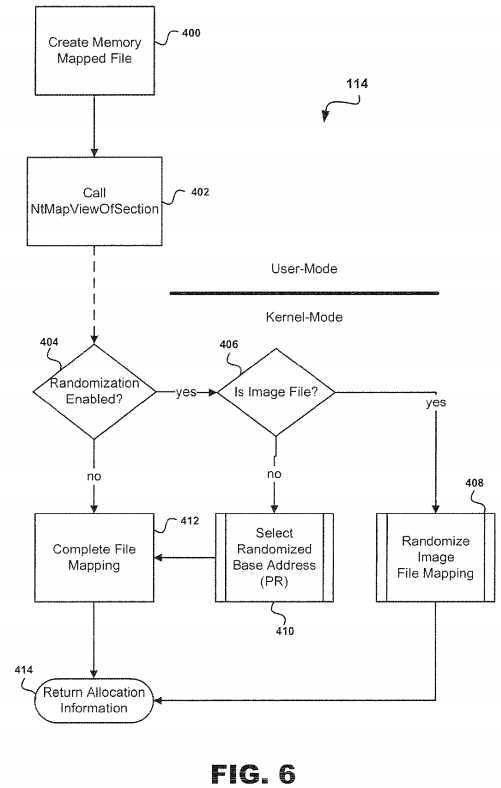
At decision point?406, the ASLR system?10?determines whether the memory region?18?is an image file or not. If the memory region?18?is an image file, then the ASLR system?10?executes subroutine?408?for randomizing the file mapping?14and then proceeds to step?414.
However, if the ASLR system?10?determines that the memory region?18?is not an image file then system?10?proceeds to execute subroutine?410?that selects a randomized base?address?for?address?space?16. Once a randomized base?addressis selected, the ASLR system?10?proceeds to step?414.
A more detailed implementation of the ALRS system?10?embodied in steps?404-414?for the MmMapViewOfSection hook is illustrated in?FIG. 9. At decision point?700?the ASLR system?10?determines whether the control area flags have an IMAGE flag set. If so, then at decision point?702?is reached to determine whether FilePointer is not NULL. If not, then ALSR system?10?proceeds directly to decision point?712?in order to determine whether the control area flags have the BASED flag set. These series of checks are used to determine if the file that is being mapped is an image file, and whether or not the file mapping is based, meaning that it should be loaded at a specific?address.
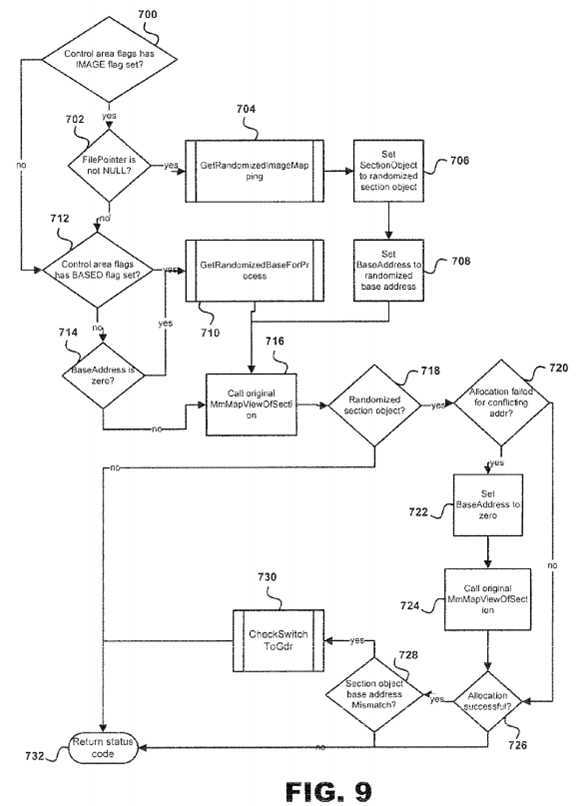
At decision point?702, if the FilePointer is not NULL, then a subroutine?704?is executed for a GetRandomizedImageMapping application as shall be discussed in greater detail below. Once the subroutine?704?is completed, then at step?706?SectionObject to randomized section object is set before proceeding to step?708?so that the BaseAddress is set to a randomized base?address. Afterwards, ASLR system?10?calls the original MmMapViewOfSection application at step?716.
If the FilePointer is NULL, then decision point?712?is reached to determine whether the control area flags have the BASED flag set or not. If the BASED flag is set, then subroutine?710?for implementing GetRandomBasedForProcess application is executed before reaching step?716?as described above. However, if the BASED flag is not set, then a decision point?714?is reached to determine whether the BaseAddress is zero or not. If the BaseAddress is zero, then subroutine?710?is executed as described above. If the BaseAddress is not zero, then the ASLR system?10?proceeds directly to step?716?as described above.
Once Call original MmMapViewOfSection is completed at step?716, then a decision?718?is reached in order to determine whether a section object is randomized. If the section is randomized, then a decision point?720?is reached to determine whether the allocation failed because of a conflicting?address. However, if the section object is not randomized, then a Return status code is executed at step?732.
At decision point?720, if the allocation failed because of a conflicting?address, then the BaseAddress is set to zero at step722?followed by step?724?for calling the original MmMapViewOfSection. Once completed, decision point?726?is reached to determine whether the allocation was successful. If the allocation was successful, then decision point?728?is reached to determine whether the section object base?address?is a mismatch. This comparison is made between the base?addressreturned by the call to the original MmMapViewOfSection and the base?address?conveyed by the section object itself. This check is necessary in order to determine the proper structure definitions to use for the operating system in question, for example the Windows platform?8. If there is a mismatch between the base addresses, then subroutine?730?is executed for a CheckSwitchtoGdr application followed by step?732?as described above. However, if the allocation is not successful then step?732?is executed.
Referring to?FIG. 10, subroutine?704?will be discussed in greater detail. At decision point?800?a determination is made on whether the section object is randomized. If the section object is randomized, then decision point?802?is reached to determine whether the ViewSize is zero or not. However, if the section object is not randomized, then the return status code at step?816?is executed.
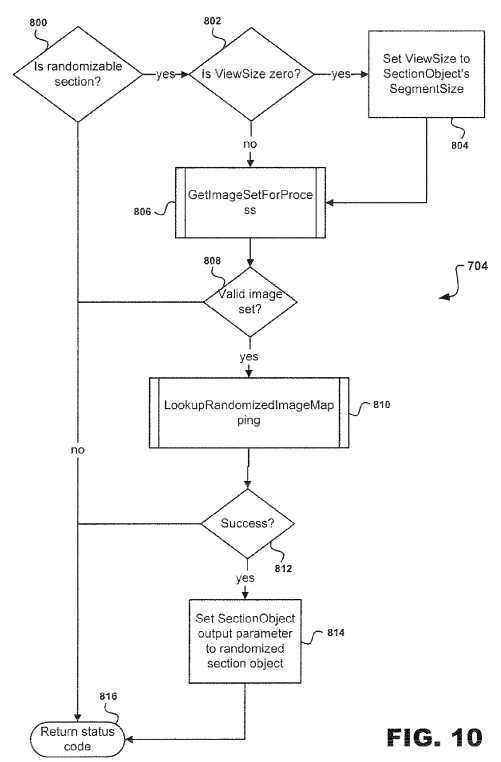
At decision point?802, if the ViewSize is zero, then ViewSize is set to SectionObject‘s SegmentSize at step?804?followed by execution of subroutine?806. However, if the ViewSize is not zero, then the ASLR system?10?executes subroutine?806?for an GetImageSetForProcess application.
After completion of subroutine?806, then decision point?808?is reached for determining whether a valid image is set or not. If the valid image is set, then subroutine?810?for LookupRandomizedImageMapping application is executed. Once execution of subroutine?810?is completed, then decision point?812?is reached for determining whether subroutine?810?was successful or not. Decision point?812?is used to determine if a randomized image mapping was found for the file mapping that is currently being randomized. If successful, then at step?814?SectionObject output parameter is set to randomized section object before the return status code at step?816.
Referring to?FIG. 11, subroutine?704?illustrated in?FIG. 10?will be discussed in greater detail. At step?900, FindRandomizedImageMapping application is executed followed by decision point?902?in order to determine whether the FindRandomizedImageMapping application was successful. If successful, then the ASLR system?10?proceeds to step?904to set Create Flag to true. However, if the FindRandomizedImageMapping application was not successful, then subroutine906?is executed to expire existing mapping which, if expired, sets the Create Flag to true. However, if an existing randomized image set mapping for this section object, then a determination is made on whether the section object has been mapped at least once. If not, then the ASLR system?10?will expire the section object and create a new randomized image set mapping.
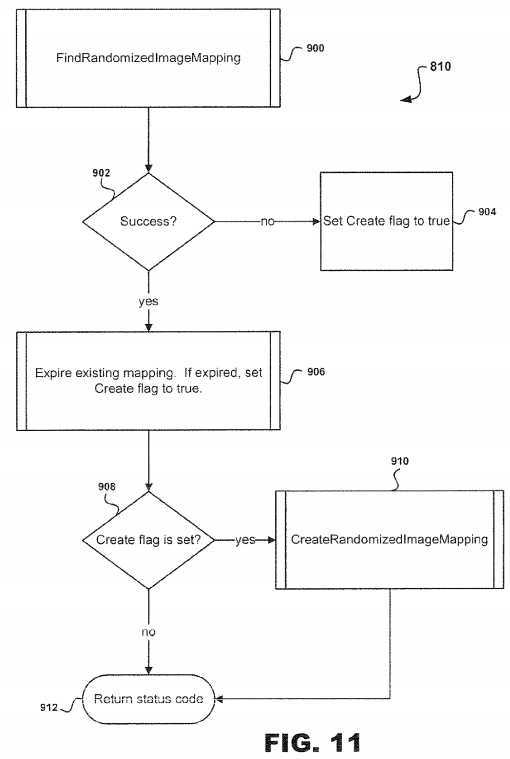
Once subroutine?906?is completed, the ASLR system?10?proceeds to decision point?908?to determine whether the Create Flag is set. If the Create Flag is set, then subroutine CreateRandomizedImageMapping application is executed followed by step?912?for return status code. However, if the Create Flag is not set, then the ASLR system?10?proceeds directly to step912?as described above.
Referring to?FIG. 12, subroutine?901?illustrated in?FIG. 11?will be discussed in greater detail. At decision point?1000, the ASLR system?10?determines whether the map is in the current process context. This check is made to see if the image mapping should occur in the context of the calling process, where context is defined as the?address?space. If the map should not be performed in the current process context, then at step?1002, the ASLR system?10?attaches to system process followed by step?1004?which executes an NtOpenFile routine such that an image file?14?is opened for reading by the system?10. However, if the map is in the current process context, then the ASLR system?10?proceeds directly to step1004.
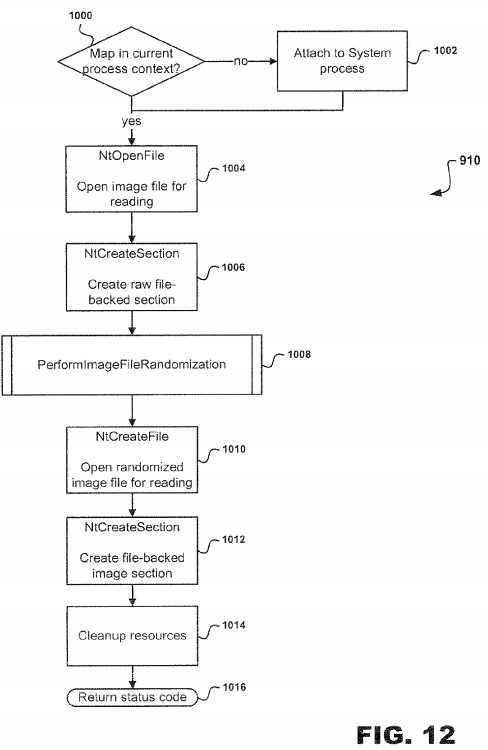
After step?1004?is completed, the NtCreateSection routine is executed at step?1006?in order to create a raw file-backed section. The NtCreateSection routine allows the caller to create a new section object, such as a file-backed section or pagefile-backed section. In order to create a file-backed section the FileHandle parameter must point to a valid file handle with which to associate the section. Otherwise, the section will be created as a pagefile-backed section. In addition, the NtCreateSection allows the caller to create a named section object that can be subsequently accessed with NtOpenSection. The NtCreateSection routine can be accessed from user-mode through ntdll!NtCreateSection which is a stub for transferring control to the kernel-mode implementation that resides in nt!NtCreateSection. Once a raw file-backed section is created, a PerformImageFileRandomization subroutine?1008?is executed as shall be discussed in greater detail below.
After subroutine?1008?is executed, the NtCreateFile routine is executed at step?1010?in order to open a randomized image file for reading by the ASLR system?10?followed by step?1012. At step?1012, the NtCreateSection routine is executed for creating a file-backed image section. Once the file-backed image section is created, then at step?1014?resources are cleaned up followed by a return status code at step?1016, thereby completing subroutine?910. One subroutine?910?has completed, the current state will be such that a randomized section object has been created and returned that can be subsequently used to create a randomized image file mapping.
Referring to?FIG. 13, subroutine?1008?illustrated in?FIG. 12?will be discussed in greater detail. At step?1100, the MmMapviewOfSection routine is executed to create mapping of a raw file-backed section. This copy-on-write view routine is used to process relocations against the raw-on-disk version. The information derived from this routine will be subsequently saved to the randomized image file on disk. After the routine at step?1100?is executed, ASLR system?10proceeds to decision point?1102?to determine whether the image is relocatable or not.
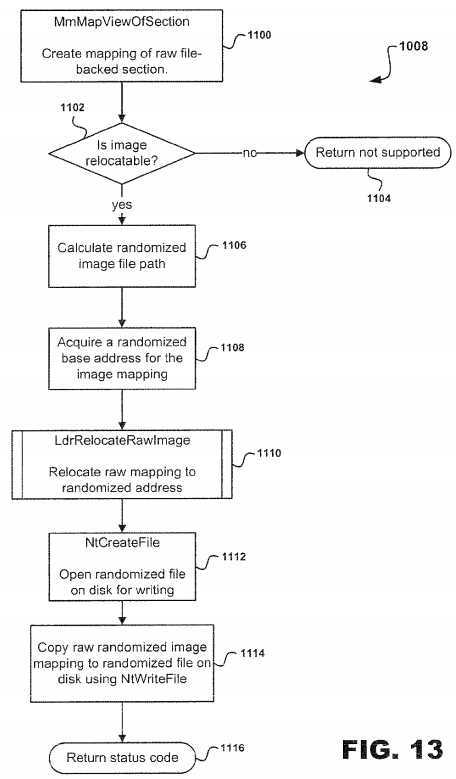
If the image is not relocatable, then the return is not support at step?1104?and the image cannot be efficiently randomized by using PE/COFF relocation information. Relocation information is information included in the binary itself that provides information necessary to change the base?address?at which an image file is located at on the fly. However, if the image is relocatable, then at step?1106?a randomized image file path is calculated. A unique path on disk must be calculated which will be used to store the randomized version of the image being filed.
At step?1108, a randomized base?address?for the image mapping is acquired followed by execution of LdrRelocateRawImage routine at step?1110. The base?address?acquired should not overlap with any other previously acquired image mapping?address?which will reduce the amount of memory overhead incurred due to copy-on-write relocations. The LdrRelocateRawImage routine relocates a raw mapping to a randomized?address. Such relocations are applied to the raw mapping according to PC/COFF relocation standards.
After execution of the LdrRelocateRawImage routine is completed, then at step?1112?an NtCreateFile routine is executed for opening a randomized file on disk for writing. At step?1114, the raw randomized image mapping is copied to a randomized file on disk using the NtWriteFile routine. Once completed, the ASLR system?10?proceeds to return status code at step?1116, thereby completing subroutine?1008.
A more detailed discussion of the above may be found in the related provisional patent application previously incorporated by reference.
As noted above, file mappings?14, and particularly image file mappings?31, are generally regarded as one of the most relied upon memory types employed by an attacker when implementing to exploit against any type of software vulnerability. The reason for this type of software vulnerability is that image file mappings?31?may be typically loaded at the same base?address?from one execution to the next execution.
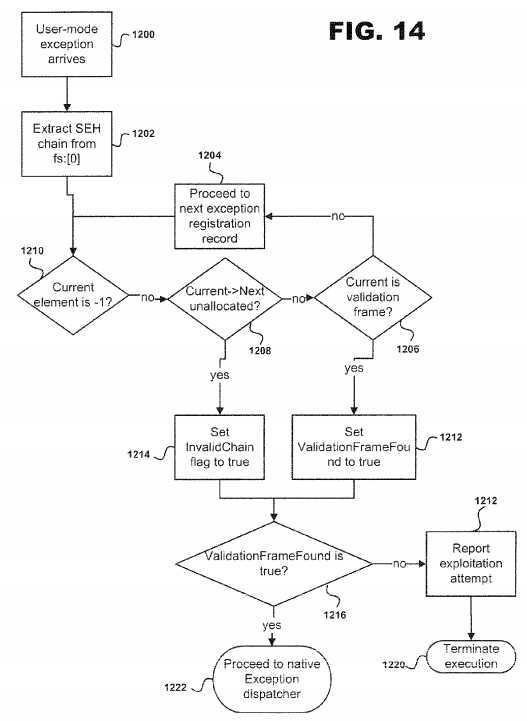
FIG. 7?provides an overview of a general implementation of the ASLR system?10?for randomizing the image file mappings31. At step?500, a memory mapped file is created by the ASLR system?10?in a user-mode application. At step?502?the NtMapViewOfSection routine is called by ASLR system?10.

The NtMapViewOfSection routine accomplishes the task of mapping the physical pages described by a section (not shown) into the?address?space?16?of a given process?9. As used herein, the term section is defined as a data structure that holds information about a portion of memory?7?that is either backed against a file on a disk (referred to as "file-backed") or the pagefile (referred to as "pagefile-backed). The physical pages described by the section are typically meant to be mapped into the?address?space?16?of one or more processes?9. Since a view of an individual section can exist in multiple processes?9?and the section itself describes only one set of physical pages, those physical pages are considered to be shared. If one process?9?were to map a view of a file-backed section object for write access and were to make a change, all other processes?9?with a view of the same area of the file on disk would be able to see the change.
The method by which the pages of a section are mapped into memory is dependent on both the parameters passed into a NtMapViewOfSection routine and on the parameters that were passed into the call to a NtCreateSection routine originally. The NtCreateSection routine allows the caller to create a new section object. As described above, there are two types of logical sections that can exist: file-backed sections and pagefile-backed sections. In order to create a file-backed section the FileHandle parameter must point to a valid file handle with which to associate the section. Otherwise, the section will be created as a pagefile-backed section.
Once step?502?is completed, the ASLR system?10?enters a kernel-mode application which proceeds to decision point?504to determine whether?randomization?has been enabled. If?randomization?has been enabled, then ASLR system?10proceeds to decision point?506?in order to determine whether the memory region?18?is an image file mapping?31. However, if?randomization?has not been enabled, then at step?514?a file mapping?14?is completed and ASLR system?10?proceeds to step?516?for return allocation information and the subroutine?116?is completed.
At decision point?506, if the memory region?18?is not an image file mapping?31, then a subroutine?508?is executed which randomizes the file mapping?14. Once?randomization?has been completed, the ASLR system?10?may proceed to step?516and the subroutine?116?is completed. However, if the memory region?18?is an image file mapping?31, then subroutine?510is executed which selects a randomized base?address. After the base?address?has been randomized, a subroutine?512?is executed which relocates the image and then the file mapping?14?is completed at step?514. After step?514, the ASLR system?10?may proceed to step?516?and subroutine?116?is completed.
One attack vector that is unique to the Windows platform is what is known as an SEH, or Structured Exception Handler, overwrite. This attack vector involves an attacker overwriting data structures that are stored on the stack which are used whenever an exception, such as an access violation, is dispatched. The act of dispatching an exception involves the kernel passing information about the exception that occurred to the thread that the exception occurred in. It does this by enumerating a list of registered exception handlers, all of which are stored on the thread stack. This gives the thread an opportunity to recover from the exception and continue executing.
If an attacker is able to use a stack overflow to overwrite a registered exception handler on the stack, then it is possible for that attacker to gain execution control. The protection mechanism described in this document establishes an algorithm that can be used to detect and prevent an attacker from being able to leverage an SEH overwrite. It accomplishes this by adding a security check to the exception dispatching process that ensures that all registered exception handlers are valid prior to allowing the operating system provided exception dispatcher to continue.
SEH overwrite protection functions by hooking a NtCreateThread routine in kernel-mode application. When NtCreateThread is called an APC is queued that executes code in the context of a thread?13?which installs a validation frame. The validation frame provides a marker and is placed at the tail end of the exception registration record list which is found within the NT_TIB structure and can be located at fs:[0].
To detect this marker, the user-mode exception dispatcher, KiUserExceptionDispatcher routine is hooked. When an exception is dispatched, the hook walks the exception registration record chain to make sure that the hook can reach the validation frame that was installed when the thread was created. If the validation frame cannot be reached, the hook assumes that the exception registration record list has been corrupted and that an exploitation of any software vulnerability is possible.
Referring to?FIG. 14, at step?1200, the user-mode exception arrives through the kernel dispatching exception information and handing off that information to a thread. An SEH chain is then extracted from fs:[0] at step?1202?followed by decision point?1210?in order to determine whether the current element is ?1 or not. The current element is defined as the current exception registration record in the exception handler list. If the current element is not ?1, then decision point?1208?is reached to determine whether the current element is lower or equal to the next unallocated current element. If the current element is ?1, then the decision point at?1216?is reached which will be described in detail. At decision point?1208, if the next element points to unallocated memory, then at step?1214?the InvalidChain flag is set to true. However, if the next element points to valid memory, then decision point?1212?is reached in order to determine whether the current element is a validation frame. If the current element is a validation frame then the ValidationFrameFound is set to true. However, if the current element is not a validation frame then execution proceeds to?1204?which selects the next exception registration record from the chain. This cycle continues in a loop until one of the conditions results in execution reaching?1216.
Once either steps?1212?or?1214?are completed, then decision point?1216?is reached in order to determine whether the ValidationFrameFound is true. If the ValidationFrameFound is true, then the ASLR system?10?at step?1222?proceeds to native exception dispatcher, The native exception dispatcher will pass the exception information onto all of the registered exception handlers. This operation is safe to occur only after the validation frame has been found because it proves that the list of registered exception handlers has not been corrupted, such as what might occur as the result of a stack overflow. Step?1222?completes implementation for SEH overwrite protection. However, if the ValidationFrameFound is not true, then an exploitation attempt is reported at step?1218?followed by step?1220?which terminates execution of the procedure.
A more detailed discussion of the above may be found in the related provisional patent application previously incorporated by reference.
It should be understood from the foregoing that, while particular implementations have been illustrated and described, various modifications can be made thereto and are contemplated herein. It is also not intended that the invention be limited by the specific examples provided within the specification.
SRC=https://www.google.com.hk/patents/US7546430
Method of address space layout randomization for windows operating systems
标签:des style blog http color os io ar strong
原文地址:http://www.cnblogs.com/coryxie/p/3962577.html